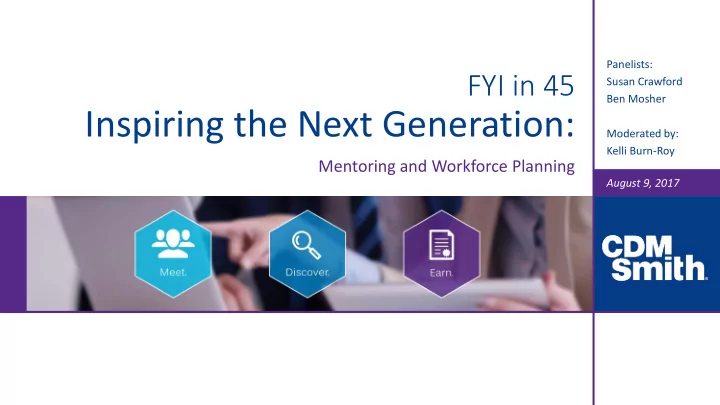

Panelists: FYI in 45 Susan Crawford Ben Mosher Inspiring the Next Generation: Moderated by: Kelli Burn-Roy Mentoring and Workforce Planning August 9, 2017
Before we begin … Recording in All phones are Questions progress on mute encouraged
Our Panel Featured Speakers Moderator Susan Crawford, PE, BCEE Ben Mosher, PE, BCEE Kellene Burn-Roy, PE Senior Vice President, Technical Delivery Manager, Technical Services Unit President Director of Technical Advancement Senior Environmental Engineer
Today’s discussion will focus on … Understanding the Importance Mentoring and Workforce Planning Showcasing CDM Smith’s Successful Programs and How Other Organizations could Apply Similar Approaches How technology, distance, and generational difference affect mentoring and workforce planning
How do you find, keep and grow an inspired staff?
10-Year Projected Employment Growth in Science and Engineering Occupations 15.7% 10.3% 9.2% 8.6% Source: National Science Board, 2016 Science and Engineering Indicators
Baby boomers are projected to make up over 40% of the STEM Workforce by 2022 Labor Force Projections for 2022 100% 90% 80% 70% 60% 50% 40% 30% 20% 10% 0% 1992 2002 2012 2022 16 to 24 25 to 54 > 55 Source: U.S. Dept of Labor, Bureau of Labor Statistics
Strategic Workforce Planning ▪ Right People ▪ Right Place ▪ Right Time
Mentoring According to Harvard Business Review (Roche): ▪ 65% of the 1,250 top executives listed in the Wall Street Journal had at least one important mentor ▪ Mentored personnel had higher salaries, more rapid promotions, greater achievement of career objectives, and higher job AND life satisfaction.
Can you give us some specific examples of these programs you’ve introduced?
CDM Smith Structured Mentoring Program ▪ Mentees: ▪ 725 mentees enrolled ▪ 82% participation for target staff (Levels 1-4) ▪ Mentors: ▪ Approximately 900 volunteers ▪ 675 mentors enrolled across all business units ▪ Total Participation: ▪ ~1400 staff
Keys to Mentoring Program Success ▪ Continuously monitor success of pairings through direct managers and firm-wide coordinators ▪ Ongoing education opportunities ▪ Regularly “refresh” pairings to allow for new or additional relationships ▪ Make sure the program remains current, relevant and sustainable
Technical Specialist Development Program What is it? ▪ At CDM Smith, we have three levels of technical professionals: ▪ Practice level (Grades 4-6) ▪ Mid-master level (Grades 6-8) ▪ Senior master level (Grades 8-10) ▪ This is a 2-year program to aid in developing both our mid-master and practice level professionals ▪ Rigorous process that pairs one mentor with two mentees in their technical specialty and includes development and execution of a detailed 2-year career development plan tailored to each mentee.
Technical Specialist Development Program (cont.) ▪ Mentees are expected to: ▪ Advance technical expertise ▪ Increase technical luminescence ▪ Improve networking ▪ Market their specific technical specialty to support our business strategy and increase technical supremacy in the marketplace
Technical Specialist Development Program (cont.) ▪ Mentees are expected to: ▪ Advance technical expertise ▪ Increase technical luminescence ▪ Improve networking ▪ Market their specific technical specialty to support our business strategy and increase technical supremacy in the marketplace
What is the right balance between structured and unstructured?
Structured and Unstructured Mentoring
What sort of skills are you developing training for – technical skills or soft skills?
Balance of skill sets Soft Technical Skills Skills
How do generational differences come into play?
Generational differences Our four-generation workforce provides challenges ”Write me” ”Call me” ”Email me” ”Text me” Seniors Baby Boomers Gen Xers Gen Yers/Millennials b. 1920-1945 b. 1946-1965 b. 1966-1979 b. 1980-2000
Mentoring the Gap and What to Consider ▪ Expectations ▪ Career ▪ Communication ▪ Management Style ▪ Feedback ▪ Change
How do you track and reward participation?
CDM Smith President’s Award for Mentoring
How has technology changed mentoring?
Are there things the mentee can teach the mentor?
Do you have any advice for organizations who are looking to begin or strengthen their programs?
Closing Thoughts: Inspiring the Next Generation ▪ Employees are our greatest asset — invest in them! ▪ Have a formal mentoring program(s) ▪ Use technology to your advantage ▪ Recognize gaps and identify how to fill them ▪ Adapt and change when needed
“ Success isn’t just about what you accomplish in life, it’s about what you inspire others to do . ”
Contact Information Featured Speakers Moderator Susan Crawford, PE, BCEE Ben Mosher, PE, BCEE Kellene Burn-Roy, PE Senior Vice President, Technical Delivery Manager, Technical Services Unit President Director of Technical Advancement Senior Environmental Engineer burnroykm@cdmsmith.com 760-710-4687 crawfordsl@cdmsmith.com mosherbr@cdmsmith.com 214-346-2867 603-222-8381
Thank You
Recommend
More recommend